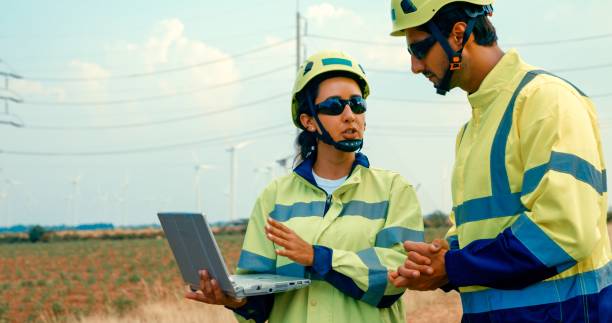As the world shifts toward cleaner, renewable energy, wind farms have emerged as a vital part of the sustainable energy landscape. Building a wind farm is a promising venture that can generate green energy while reducing carbon footprints and supporting local economies. However, creating a successful wind farm requires careful planning, strategic execution, and a deep understanding of environmental, technical, and financial factors. Here are essential tips to help you navigate the process of building a sustainable wind energy project.
1. Conduct a Thorough Site Assessment
The foundation of any successful wind farm lies in choosing the right location. Wind farms need steady, strong winds to maximize energy output, so a comprehensive site assessment is the first critical step. Use wind resource assessment tools such as anemometers to collect wind speed and direction data over a period of 12 months or more. This data helps estimate the energy production potential and informs turbine placement.
Besides wind resources, evaluate the site’s geography, topography, and proximity to the electrical grid. Areas with minimal obstacles like tall buildings or dense forests will generally yield better wind speeds. Additionally, consider access roads for transporting equipment and construction materials. A well-chosen site optimizes performance and reduces operational costs.
2. Understand Environmental and Regulatory Requirements
Wind farm projects need to adhere to a range of environmental regulations to reduce their effects on local wildlife and ecosystems. Engaging environmental consulting services is essential to conduct a thorough environmental impact assessment (EIA), which helps identify potential risks to plants, animals, and habitats. This assessment typically includes collaboration with environmental agencies and community stakeholders to ensure all concerns are addressed.
Special attention should be given to bird and bat migration routes, as turbine blades can pose significant risks to these species. To minimize harm, turbine layouts should be carefully designed, and technologies such as ultrasonic deterrents can be employed to lessen negative impacts. Additionally, it is important to work closely with environmental consultants to navigate zoning laws, obtain necessary permits, and comply with other regulatory requirements that could influence the project timeline.
3. Choose the Right Turbines and Technology
Selecting the appropriate turbines is crucial for maximizing energy generation and ensuring long-term reliability. Turbine size, capacity, and technology should align with the site’s wind conditions and project goals. Modern turbines come in various sizes, ranging from small-scale units for community projects to massive utility-scale machines generating several megawatts each.
Look for turbines with high efficiency, durable components, and advanced control systems that optimize blade pitch and rotation speed. Investing in reliable, cutting-edge technology can improve the farm’s performance and reduce maintenance costs over time. Additionally, consider turbines with grid-friendly features, such as reactive power control, to support grid stability.
4. Develop a Robust Project Plan and Budget
Wind farm projects involve significant upfront investment, including costs for land acquisition, equipment, construction, and grid connection. Developing a detailed project plan and realistic budget is essential for securing financing and managing resources effectively.
Include contingencies for unexpected expenses, such as delays or equipment issues. Work closely with engineers, contractors, and legal advisors to estimate costs accurately and set achievable milestones. Financing options may include private investors, government incentives, grants, or partnerships with utility companies. Understanding your funding sources will help guide project scale and scope.
5. Engage and Communicate with the Community
Community support can make or break a wind farm project. Local residents may have concerns about noise, visual impacts, or land use, so early and transparent communication is key. Hold public meetings, share project plans, and listen to feedback to address concerns proactively.
Highlight the benefits of the wind farm, such as job creation, increased local revenue, and environmental advantages. Consider involving the community in decision-making processes or offering incentives like discounted energy rates or community ownership stakes. Building strong relationships can lead to smoother project approvals and long-term success.
6. Plan for Efficient Construction and Installation
Construction of a wind farm requires meticulous coordination among suppliers, contractors, and engineers. Plan logistics for transporting heavy turbine components, such as blades and towers, to the site. Ensure that roads, bridges, and cranes can handle the size and weight of the equipment.
Work with experienced construction firms specializing in wind energy to optimize timelines and quality. Safety is paramount during installation, as working at height and with heavy machinery presents risks. Implement strict safety protocols and conduct regular training to protect workers and equipment.
7. Implement Smart Operation and Maintenance Practices
Once the wind farm is operational, ongoing maintenance is crucial for sustaining performance and extending turbine lifespan. Use remote monitoring systems to track turbine health, energy output, and environmental conditions in real-time. Early detection of faults or wear can prevent costly breakdowns.
Schedule routine inspections, lubrication, and component replacements based on manufacturer recommendations and operational data. Training a skilled maintenance team or partnering with specialized service providers ensures quick response times and efficient repairs. Keeping turbines in optimal condition maximizes energy production and financial returns.
8. Monitor and Report on Environmental Impact
Sustainability means not just producing clean energy, but doing so responsibly. Continue monitoring the environmental impact of your wind farm throughout its lifecycle. Collect data on wildlife interactions, noise levels, and any changes to the surrounding habitat.
Use this information to improve operational practices and comply with reporting requirements from regulatory bodies. Transparent environmental stewardship enhances your project’s credibility and can open doors to future opportunities.
Final Thoughts
Building a wind farm is a complex yet rewarding endeavor that contributes significantly to the transition toward renewable energy. Success depends on careful site selection, regulatory compliance, smart technology choices, community engagement, and rigorous operational practices. By following these essential tips, you can develop a sustainable wind farm that not only powers homes and businesses but also supports environmental health and economic growth. The wind is a powerful ally—harness it wisely for a cleaner, greener future.


